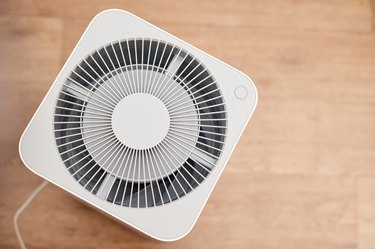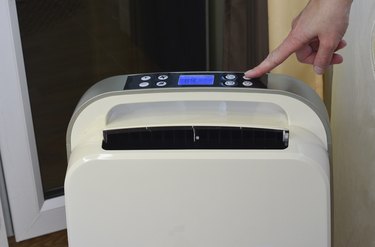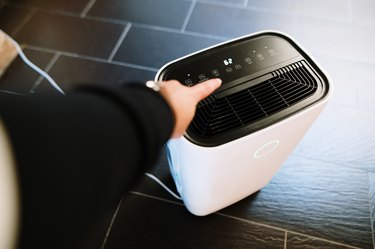
Dehumidifiers are designed to pull warm, humid air into the unit and separate the water from the air, collecting the water in a tank and sending the dried air back into the living space. Removing excess moisture from the air keeps your home healthy by preventing water damage in damp areas, like crawl spaces and basements. Even more importantly, dehumidifiers can help keep you and your family healthy by preventing mold growth and curbing dust mites in the air you breathe every day.
When a dehumidifier won't do its job and stops removing moisture from the air, the culprit could be the filters, coils, humidity sensor, or many other parts of the appliance. The solution could be as easy as routine maintenance or a quick reset. Resetting your dehumidifier won't fix everything, though. To remedy a broken dehumidifier, here are nine common dehumidifier problems and how to fix them.
Video of the Day
Video of the Day
1. Dehumidifier Overflowing
Dehumidifiers are quite effective at lowering your home's humidity level to the desired 30 to 50 percent. Pulling all that water out of the air means the water collection tank fills up. Common dehumidifier technology comes with a float assembly that triggers the appliance to shut off when the tank is full. If the float assembly is stuck or is off kilter, then the water tank can overflow as the machine continues to run. Here's how to reset the float assembly:
- Unplug the unit, remove the reservoir tank, empty it, and set it aside.
- Locate the float assembly at the tank. Gently move the float from side to side to make sure it's not stuck.
- Check that the water level float is set to the desired shutoff point (some models have a low level setting option, so the tanks is less full when the unit shuts off).
- Insert the water tank until it clicks into place.
Tip
If your dehumidifier has a drainage hose, check the hose for kinks or blockages that could be causing water to overflow.
2. Dehumidifier Leaking
Water leaks around a dehumidifier are the last thing you want to come across when you're trying to remove moisture from your environment. Unplug the dehumidifier and check a few parts to solve a leaking problem.
- Jostle the float assembly to make sure it's not stuck. A stuck float assembly could fail to signal that the reservoir is full.
- Remove the reservoir tank and check for any cracks or damage. If you observe cracks that are leaking water, use waterproof repair tape to repair the leaks until a replacement part arrives.
- Inspect the drain hose for leaks (if you're using one). Also check the connection where the hose meets the machine or an adaptor, tighten the connection if necessary.
- Check the drain plug. Some dehumidifier models have a drain plug that prevents water from flowing out of the machine when a drain hose is not in use. Remove and reinsert this plug to make sure it's properly seated.
- Clean the drain tube. A drain tube runs from the evaporator pan to the reservoir tank. A blockage in this tube can result in water leaking out of the dehumidifier instead of being guided into the tank. Remove the water tank and find the drain tube secured to the drip tray. Clear the tube of any blockages by inserting a straw or pen into the tube.
- Defrost the unit. Leaking could be due to frost formation on the evaporator coils. Defrost the dehumidifier per the manufacturer instructions.
3. Dehumidifier Is Icing Up
Dehumidifiers don't take kindly to the cold, and they'll let you know when it's too cold by literally freezing up. Many dehumidifier models will freeze up when placed in a room temperature below 65 degrees Fahrenheit. However, some models are advanced enough to stay in colder basement temperatures without freezing. Check with the manufacturer for the specific operating temperature for your appliance. Here's how to warm up your dehumidifier so it can work properly again.
- Unplug the dehumidifier and allow the coils to thaw completely. Alternatively, use "fan only" (if that setting is available on your model) to thaw the coils.
- Clean the air filters. Poor airflow from the warmer external air causes the refrigerant to freeze the coils.
- Move the dehumidifier to a warmer location, if necessary, to prevent freezing up again.
4. Dehumidifier Not Working or Turning On

Dehumidifiers have several components that can act as switches to shut down the machine if there's a problem or malfunction. If your dehumidifier will not turn on, there's a good chance it's related to one of the following parts:
Float Assembly and Bucket Level Switch
The parts that monitor the water level in the reservoir tank work together to shut off the dehumidifier compressor and fan if the water level gets too high. If the float gets stuck or misaligned and isn't moving properly, it can activate the bucket level switch (which shuts off the unit) even when the water level is low. If the dehumidifier is not running and the light indicating a full reservoir is not illuminated, the float assembly may be activating the bucket level switch, or the switch may have failed.
Humidity Sensor
Dehumidifier models with electronic controls use a humidity sensor to monitor the humidity in the room and turn the dehumidifier on and off based on the humidity setting. The sensor connects to the electronic control board with wiring harness. The harness can come loose and can be reseated to restore the connection. If the sensor itself fails, it can be replaced.
Humidistat
Dehumidifiers that do not have electronic control use a humidistat to monitor the room's humidity level and turn the unit on and off accordingly. The humidistat has two electrical contacts that touch together to activate the dehumidifier's compressor and fan. These contacts can become badly corroded, or they can stick together, causing the machine to stay off. When it's working normally, a humidistat makes an audible click when you turn up the humidity setting above the room's humidity level. If you listen carefully and do not hear this click, the humidistat may have failed. It's a relatively inexpensive, replaceable part.
Electronic Control Board
The electronic control board (PCB) is the brain of an electronic dehumidifier. Failure of the PCB prevents the dehumidifier from working or turning on, but there's no easy test for a failed board. When a dehumidifier is not working, technicians look to the PCB only after checking all other parts that can prevent a unit from turning on. The PCB is replaceable, but this can be an expensive repair.
5. Clogged Filter in Dehumidifier
The efficacy of dehumidification depends on the airflow around the coils. If air can't get into the chamber where the coils are located, or it can't get out, the humidity around the appliance won't change, rendering the dehumidifier ineffective. Here's how to fix a clogged air filter in a dehumidifier.
- Many dehumidifiers have two filters: one on the inflow side and one on the outflow side. Remove both filters.
- Use soap and water to routinely clean the dehumidifier and keep it working in top form. Replace a filter if it won't come clean with soap and water.
- Let the filters dry, then reinstall them and restart the unit.
Tip
You may need to consult the manual to determine how to access the filters. If you don't have a manual, you can find one on the manufacturer's website or by doing an online search of the make and model of the dehumidifier followed by the word "manual."
6. Dehumidifier Condenser Stopped Working
There are a few symptoms that indicate the condenser is not working or is failing to turn on. This is a big mechanical part that makes of lot of sound when it runs; if the only sound you hear coming from the dehumidifier is the fan, the condenser is not coming on. This also means the coils at the back of the unit are not getting cold, and no water is going into the reservoir tank or down the drain (if you're using a drain hose).
Here are the most common causes of a dehumidifier condenser that has stopped working.
Room Temperature
Dehumidifiers can ice up in room temperatures below 65 degrees Fahrenheit. Ice builds up on the condenser coils, causing the compressor to shut down to prevent damage to the machine. If the room temperature has fallen below 65 F, follow the steps above to deice the dehumidifier, then move the machine to a warmer area, or warm up the original location to above 65 F, before restarting the unit.
Full Reservoir Tank
Failing to empty the reservoir tank results in the compressor or the entire unit shutting down to prevent an overflow of water. Check the water level in the reservoir, and empty the tank if necessary.
Capacitor
A capacitor works somewhat like a battery to give the compressor a boost of power to help it start up. If everything else with your dehumidifier seems to be working normally but the compressor won't start, a failed capacitor is a likely culprit. This is an inexpensive part that is easy to replace, but a capacitor can deliver a dangerous electrical shock if it's not handled properly, so this is a job for a service technician.
Control Board
The electronic control board (PCB) on electronic dehumidifiers controls many of the unit's functions, including the compressor. A control board can be tested for failure and, if necessary, replaced by a service technician.
7. No Air From Dehumidifier Grille

If you can hear the condenser running but you can't feel any air coming from the front grille, the fan may be stuck or broken. This is how to fix a stuck fan in a dehumidifier:
- Unplug the unit.
- Using a screwdriver, unscrew the grille face from the dehumidifier, exposing the fan.
- Remove any blockages that are preventing the fan from spinning.
- Spin the fan blades by hand to see if it spins smoothly. If it feels loose, look for a setscrew on the side of the fan blade assembly, and tighten the setscrew if necessary. If the blades do not spin freely, the fan motor may be damaged and need to be replaced.
- Reinstall the grille face and plug in the dehumidifier.
8. Dehumidifier Smells Bad
Dehumidifiers are hard at work removing moisture that can lead to mold growth and dust mites. But as machines that work with moisture, if they aren't routinely cleaned, mold and mildew can spread throughout the components of the machine. Here's how to clean a dehumidifier.
- Unplug the dehumidifier and put on protective cleaning gloves.
- Wash the external grille with warm water and mild dish soap.
- Remove the reservoir tank, and fill it about halfway with clean, warm water and same dish soap. Scrub all interior surfaces of the tank with a scrub brush or sponge. Rinse and dry the tank.
- Remove the air filters (many units have two), and clean them with soapy water. Rinse them and let them dry before reinstalling them.
9. Dehumidifier Is Noisy
A noisy dehumidifier may be as simple to fix as tightening a loose screw. Follow these dehumidifier troubleshooting steps to fix a noisy dehumidifier.
- Unplug the dehumidifier.
- Check the screws that secure the front grille. Also check the screws around the fan motor housing.
- Tighten any loose screws. Poorly secured parts may cause rattling as the dehumidifier fan blows and the compresser vibrates.
- Inspect the fan for any obstructions if the noise persists. Remove anything caught in the fan blades that is making noise.
- If you can determine that the noise is coming from the compressor, it may be a sign that it needs to be replaced. This replacement can only be done by a professional.
Where Should I Put My Dehumidifier?
Good air circulation is a must for every dehumidifier, so you'll never want to tuck it in a corner or next to bulky furniture. The distance your dehumidifier needs to be away from the wall varies by model, so check your owner's manual for specific measurements.
Close doors and windows. The exterior moisture will overload the appliance, and it won't dehumidify the room effectively.
Never put a dehumidifier on an uneven or unstable surface. Doing so could result in the dehumidifier overflowing or malfunctioning.
Put your dehumidifier close to the source of the humidity or water damage for the most effective moisture removal.
When to Call a Professional for Help
When you can't narrow down the problem to something obvious, you may be dealing with a malfunction of the refrigeration system. There could be a refrigerant leak, or the compressor may have a bad seal that prevents it from developing enough pressure to vaporize the refrigerant. You can't repair a refrigeration system yourself; federal law requires HVAC technicians who work with refrigerants to possess a Section 608 Technician Certification, Type 1.
Considering that a minimum service charge for an HVAC technician is in the neighborhood of $100 to $250 even before any repairs are completed, it's probably not cost-effective to repair a unit with a compromised refrigerant system. It usually makes more sense to dispose of the unit according to local law and buy a new dehumidifier.
How to Reset a Dehumidifier

As the old technical troubleshooting adage goes, "Have you tried turning it off and on again?" Sometimes, the dehumidifier just needs a reboot to resolve technical difficulties. Always check your owner's manual for specifics on safely resetting your appliance. In general, the following steps will reset a dehumidifier.
- Turn off the dehumidifier and unplug it from the outlet.
- Empty the water tank.
- Wait five minutes.
- Plug the dehumidifier back in, reset the controls, and let it run for awhile to see if it's working normally.